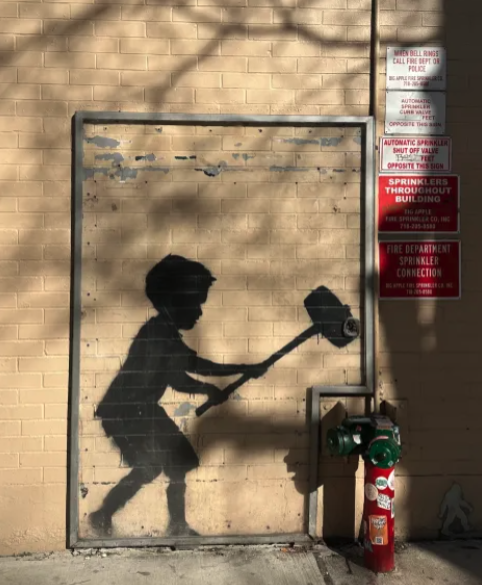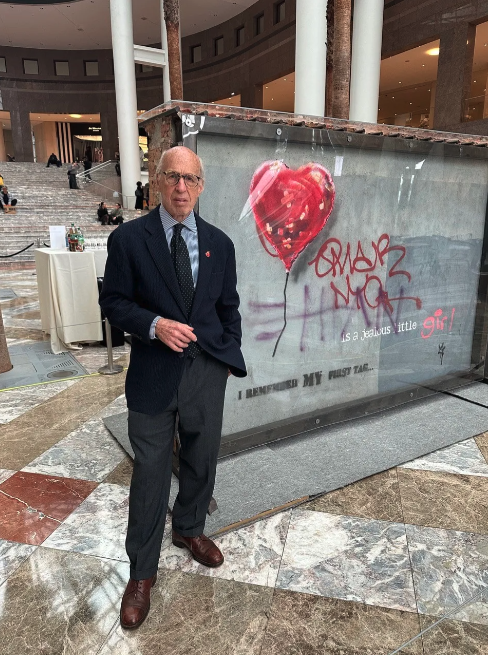It’s Born to be Wild, But Street Art Doesn’t Always Stay That Way
People remove a new artwork by Banksy, depicting a howling wolf painted on a satellite dish that was placed on a shop roof in Peckham, south London. Photo: Jordan Pettitt/PA Images via Getty Images
Originally published by Observer.
The trio of art thieves descended on their target with precision, audacity and insouciance. They wore dark hoodies, masks and gloves. They brought with them everything they would need: a ladder to gain access and tools to dislodge the art from its moorings. And within a minute, they were done, vanishing along with their prize.
It wasn’t exactly the Isabella Stewart Gardner Museum heist, but last August’s brazen daylight plunder on Rye Lane in South London netted the thieves an hours-old work by street art legend Banksy, a depiction of a howling wolf rendered on a satellite dish that was part of his London Zoo series. There were dozens of eyewitnesses, and the theft was captured in photographs and video, yet a year later, there has been no sign of the stolen artwork, and no arrests have been made.
Over the decades, as the value of street art has climbed dramatically, works created in the wild by some of the genre’s greats—Banksy, Ron English, Kenny Scharf, Invader and many others—have increasingly come into private hands. When legitimate ownership can be proven, they are sold in galleries and auction houses. Sometimes, as in the case of the stolen Banksy, they disappear into a black market abyss.
Street art gets diverted from its urban habitat in a variety of ways. There’s the perplexing set of circumstances described above in which thieves illegally make off with something of value that has no clear owner and that was created illegally. Then there’s the more common and more legitimate means, which usually involves a building owner deciding to sell a piece of brick wall that has been enriched by a work of art. Either way, the diversion of street art into private hands angers both art lovers and artists.
A Banksy in the wild on the Upper West Side of Manhattan. Photo: Jamie Lubetkin
“I am vehemently against it,” Ken Harman, whose Harman Projects galleries in New York, San Francisco and Los Angeles feature studio work by prominent street artists, told Observer. “The intention of the artist in these scenarios is that the artwork lives on as part of the public conversation. To remove the art and keep it for private use goes against what the work was made for and why it was made.”
What happens to stolen street art after it is removed from public spaces is sometimes a mystery. Police rarely recover stolen works, at least in part, because it can be unclear whether a crime has been committed, as establishing ownership is not always easy. And because legitimate galleries and auction houses won’t go near stolen stuff, a less lucrative black market may be thieves’ only option to dispose of their loot.
When building owners decide to sell work committed on their property, legitimate galleries and auctions sometimes get involved, but interest in such work has been spotty and prices have not approached those of studio-created work by the same artists. While artists frown on any form of diversion of their public work, it’s theft that really lights their fuses.
“I had my mural at Woodstock stolen, and they literally removed the façade of Fashion Moda in the Bronx with my mural on it,” Ron English, the graffiti art pioneer who is often referred to as the Godfather of Street Art, told Observer. He then quipped, sarcastically, how nice it is that people are so passionate about art before acknowledging that the motive for these thefts is the potential sale value.
“They don’t like or respect art, they want money and are willing to steal a piece of art from all of us to line their pockets. If I wanted a thief to own a piece of my art I would drop it off at their house,” added the loquacious English, whose POPaganda art practice includes street art, fine art, sculpture, toys, film, music and NFTs.
The question of ownership is vexing to law enforcement when street art vanishes and to dealers when they are presented with suspect works by prospective sellers. Peter N. Salib, a law professor at the University of Houston who wrote the seminal 2016 legal paper The Law of Banksy: Who Owns Street Art?, said property owners have the strongest ownership rights when it comes to street art, but the public also has at least a tangential interest. Artists, not so much.
“I don’t have a strong view on whether artists or the public have an interest in street art,” he told Observer. “I’m inclined to think that artists mostly don’t. Both because they’re often putting their art on somebody else’s property, and because by choosing to do so, they have, in a sense, relinquished control. As for the public, I do think the public has an interest in the art existing and being seen.”
For his paper, Salib looked at a pair of cases, including one involving a piece called Slave Labor that was painted by Banksy on the wall of a store in Haringey, London, in 2012. The owner of the building attempted to sell the piece at auction, but residents of Haringey claimed they had an interest in the work and were successful in blocking an initial attempt to sell it. Later, however, the building owner was successful in selling the piece, reportedly for around $730,000.
The purchaser? Ron English, who vowed to whitewash the piece in a statement against removing street art from the wild. He suggested that whitewashing the piece would create a new work of art, a la Robert Rauschenberg’s Erased de Kooning Drawing, which Rauschenberg created by erasing a Willem de Kooning work in 1953. English said he planned to do the whitewashing at Art Basel Hong Kong in 2020, but the show was canceled because of COVID-19. He still has the piece, but its future has not been determined.
Guernsey’s President Arlan Ettinger with the Banksy work he brought to auction for a Brooklyn property owner. Photo courtesy Guernsey's
In May, a Brooklyn family sought to sell a 7,500-pound piece of concrete wall they removed from a warehouse they owned after Banksy painted a version of his iconic balloon heart on it. They brought it to market via the auction house Guernsey’s, which is known for selling offbeat auction items like doors from the Chelsea Hotel in Manhattan.
Guernsey’s president Arlan Ettinger said his staff first set out to verify that the family actually owned the piece. Once ownership was established, the piece was offered with the starting price of $500,000. There were no bids.
“It’s a commanding piece, an attention getter, but it’s more than 7,000 pounds. Where are you going to put that? We got some offers right after the auction, but the family—lovely, working-class people—are holding out for what they believe it’s worth,” Ettinger told Observer.
Brian Swarts, president and director of Taglialatella Galleries, a leading global dealer in the work of street artists, said street art that is removed from the wild legitimately can have significant value, but it does not approach that of a work created for private markets. “There’s been a lot of debate over that over the years,” he explained. “With Banksy and some of the other leading street artists that have a lot of money attached to their work, even if it’s not a signed, numbered, studio-issued piece of artwork, there’s still some value there.”
Like the other gallery representatives, Swarts said he demands proof of ownership and other documentation demonstrating the work’s provenance before he will consider getting involved. “The only time I’ve ever sold works like that is if there’s some sort of documentation of it. Even though it’s unique, it’s not the same as selling a signed original from the studio,” he added.
While there is clearly a black market for work that doesn’t pass the galleries’ smell tests, little is known about it, even by those closest to the street art scene. Alan Ket, who owns Miami’s Museum of Graffiti with co-founder Allison Freidin, said he has not encountered black marketeers, but he noted that stolen and fake street art is sold openly on online markets like eBay. “There is a segment of the population that is unscrupulous and that wants stuff for free and who are OK with theft.”
Banksy’s work is undoubtedly the most frequently diverted; not only is it the most valuable, but it’s also among the most accessible, turning up regularly on streets around the world. One example is the rendering of a boy swinging a hammer that has graced Manhattan’s Upper West Side for years. Another is in London’s Shoreditch neighborhood and depicts a cop with a poodle on a leash. Both are protected by nothing more than plexiglass.
An Invader work in the shadow of the Eiffel Tower, Paris. Photo: J. Scott Orr
Invader, the French mosaic master who draws inspiration from early video games, is probably number two on thieves’ hit list. Rather than spray paint, Invader’s work is made of colorful tiles that thieves commonly try to remove in the hope of reassembling them elsewhere.
“Shame on them!” Invader has written of street art thieves. “Street art belongs to the street… Buyers should think twice about what they do; not only are they being duped but they are also depriving other people of enjoying free art on the street.”
Lori Zimmer, author of Art Hiding in New York, Art Hiding in Paris and the recently released I’m Not Your Muse, said the unprecedented increase in value of work by street artists has led to a commodification of a product that was once simply a source of public enjoyment. “The sale of pieces meant for the street to private hands, done by removing, or cutting, or destroying the walls they are painted on, is in some ways pretty gross,” she added, “but feels very on brand for the perversion of late-stage capitalism we are currently living in.”




